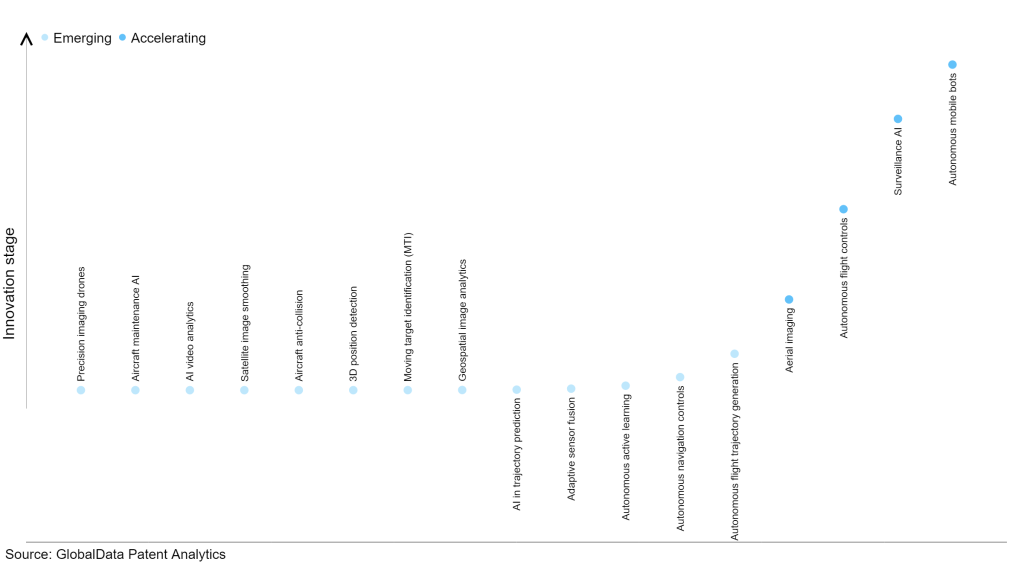The aerospace and defense industry continues to be a hotbed of patent innovation. Activity is driven by developments in artificial intelligence (AI) and machine learning, and the growing importance of technologies such as drones, satellite technology, and big data. In the last three years alone, there have been over 237,000 patents filed and granted in the aerospace and defense industry, according to GlobalData’s report on Artificial intelligence in defense: autonomous mobile bots. Buy the report here.
However, not all innovations are equal and nor do they follow a constant upward trend. Instead, their evolution takes the form of an S-shaped curve that reflects their typical lifecycle from early emergence to accelerating adoption, before finally stabilizing and reaching maturity.
Identifying where a particular innovation is on this journey, especially those that are in the emerging and accelerating stages, is essential for understanding their current level of adoption and the likely future trajectory and impact they will have.
110 innovations will shape the aerospace and defense industry
According to GlobalData’s Technology Foresights, which plots the S-curve for the aerospace and defense industry using innovation intensity models built on over 206,000 patents, there are 110 innovation areas that will shape the future of the industry.
Within the emerging innovation stage, precision imaging drones, aircraft maintenance AI, and AI video analytics are disruptive technologies that are in the early stages of application and should be tracked closely. Aerial imaging, autonomous flight controls, and surveillance AI are some of the accelerating innovation areas, where adoption has been steadily.
Innovation S-curve for artificial intelligence in the aerospace and defense industry

Autonomous mobile bots is a key innovation area in artificial intelligence
Autonomous mobile bots are robotic systems that are capable of operating and navigating without human control. These bots are designed to perform tasks and functions autonomously, using sensors, algorithms, and artificial intelligence. They can navigate through complex environments, interact with their surroundings, and make decisions based on real-time data. Autonomous mobile bots are used in various industries and applications to automate processes, enhance efficiency, and improve productivity.
GlobalData’s analysis also uncovers the companies at the forefront of each innovation area and assesses the potential reach and impact of their patenting activity across different applications and geographies. According to GlobalData, there are 290+ companies, spanning technology vendors, established aerospace and defense companies, and up-and-coming start-ups engaged in the development and application of autonomous mobile bots.
Key players in autonomous mobile bots – a disruptive innovation in the aerospace and defense industry
‘Application diversity’ measures the number of applications identified for each patent. It broadly splits companies into either ‘niche’ or ‘diversified’ innovators.
‘Geographic reach’ refers to the number of countries each patent is registered in. It reflects the breadth of geographic application intended, ranging from ‘global’ to ‘local’.
Patent volumes related to autonomous mobile bots
| Company | Total patents (2021 - 2023) | Premium intelligence on the world's largest companies |
| General Electric | 19 | Unlock Company Profile |
| General Motors | 19 | Unlock Company Profile |
| Safran | 17 | Unlock Company Profile |
| Kawasaki Heavy Industries | 21 | Unlock Company Profile |
Source: GlobalData Patent Analytics
Boeing is one of the leading patent filers in autonomous mobile bots. The aircraft manufacturer introduced its first autonomous mobile collaborative robot (cobot) called Wayne in the Boeing Aerostructures Australia 787 production facility in Port Melbourne in 2020.
Designed and engineered by the Australian branch of Boeing Research & Technology (BR&T), the mobile cobot uses AI, 3D vision systems, laser scanners, and a host of safety sensors to self-navigate and move around the complex factory environment and perform important but repetitive tasks such as sanding and cleaning, while reducing potential workplace injuries. The battery-operated cobot is equipped with lightweight robotic arms and can operate for approximately 10 hours at a time.
Some other key patent filers in this space include AeroVironment, Airbus, and Textron.
In terms of application diversity, Airbus, Boeing, and Raytheon Technologies are some of the leading patent filers. By means of geographic reach, some of the leading patent filers include Wisk Aero, Textron, and Safran.
To further understand the key themes and technologies disrupting the aerospace and defense industry, access GlobalData’s latest thematic research report on Artificial Intelligence (AI) in Defense.
Data Insights
From

The gold standard of business intelligence.
Blending expert knowledge with cutting-edge technology, GlobalData’s unrivalled proprietary data will enable you to decode what’s happening in your market. You can make better informed decisions and gain a future-proof advantage over your competitors.



